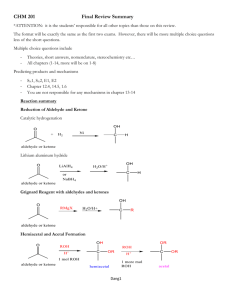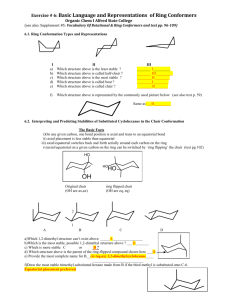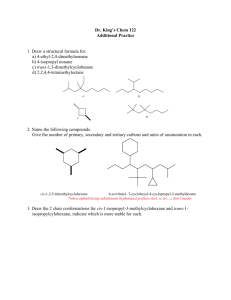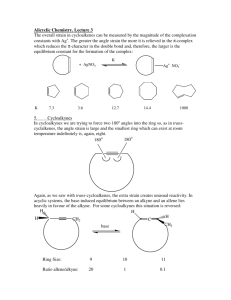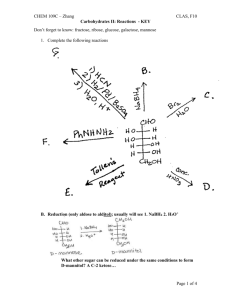Chapter 16
advertisement
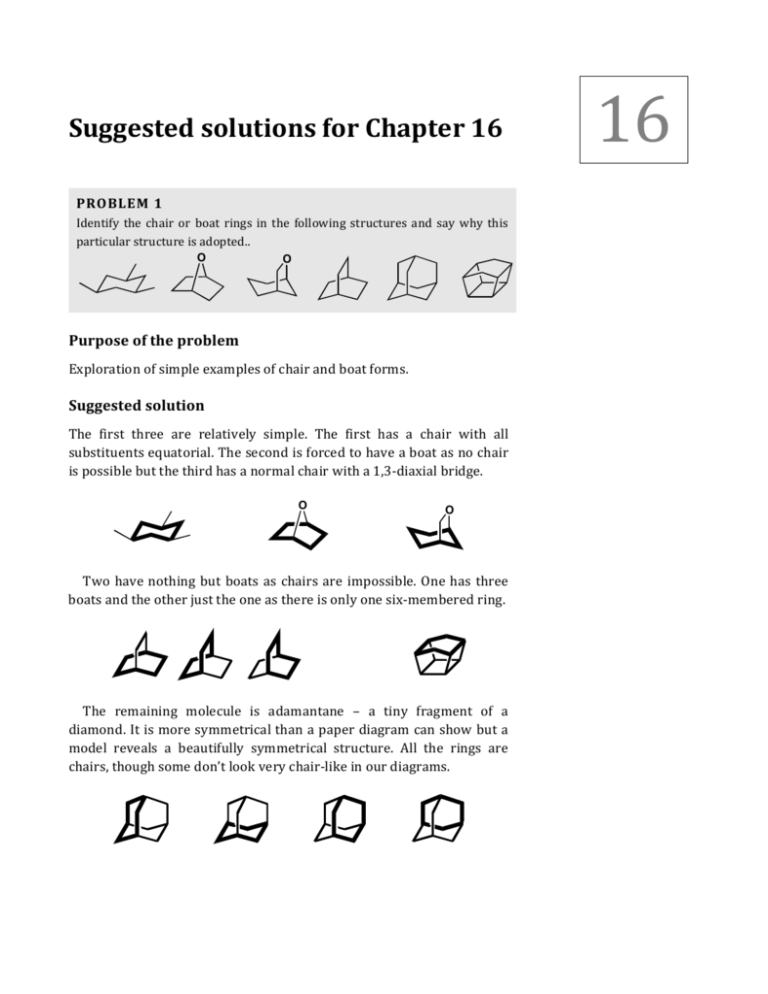
16 Suggested solutions for Chapter 16 PROBLEM 1 Identify the chair or boat rings in the following structures and say why this particular structure is adopted.. O O Purpose of the problem Exploration of simple examples of chair and boat forms. Suggested solution The first three are relatively simple. The first has a chair with all substituents equatorial. The second is forced to have a boat as no chair is possible but the third has a normal chair with a 1,3-­‐diaxial bridge. O O Two have nothing but boats as chairs are impossible. One has three boats and the other just the one as there is only one six-­‐membered ring. The remaining molecule is adamantane – a tiny fragment of a diamond. It is more symmetrical than a paper diagram can show but a model reveals a beautifully symmetrical structure. All the rings are chairs, though some don’t look very chair-­‐like in our diagrams. 2 Solutions Manual to accompany Organic Chemistry 2e PROBLEM 2 Draw clear conformational drawings of these molecules, labelling each substituent as axial or equatorial. Me Me Me OH OH OH Purpose of the problem Simple practice at drawing chair cyclohexanes with axial and equatorial substituents. Suggested solution Your drawings may look different from ours but make sure the rings have parallel sides and don’t ‘climb upstairs’ (p. 371-­‐372 in the textbook). Make sure that the axial bonds are vertical and the equatorial bonds parallel to the next ring bond but one. The first molecule has a free choice so it has both substituents equatorial. The last two molecules are dominated by the large t-­‐butyl group which insists on being equatorial so, in the last case, the Me and OH groups have to go axial. OH Me Me OH Me t-Bu t-Bu OH Solutions for Chapter 16 – Conformational Analysis PROBLEM 3 Would the substituents in these molecules be axial, equatorial, or a mixture between the two? Me H2N Me Me NH2 H2N Purpose of the problem Simple practice at drawing chair cyclohexanes and deciding whether the substituents are axial or equatorial. Remember to decide by drawing and not by trying to remember rules. Suggested solution All three molecules have a free choice as the substituents aren’t large and are about the same size. Note that all three molecles have their substituents ‘trans’ but in two they are both equatorial and in one they are axial/equatorial. NH2 NH2 Me NH2 Me Me both equatorial NH2 Me both equatorial about 50:50 — one has to go axial PROBLEM 4 Which of these two compounds would form an epoxide on treatment with base? OH H Br OH H Br Purpose of the problem Exploration of the relationship between conformation and mechanism. 3 4 Solutions Manual to accompany Organic Chemistry 2e Suggested solution The mechanism is easy (intramolecular SN2) and the conformation of a trans decalin is fixed so we can start with the conformational drawings. Me Me OH OH Br H Br H The first compound can get the necessary ‘attack from the back’ angle of 180° between the nucleophile (O–) and the leaving group (Br) for the intramolecular reaction. But this is impossible for the second compound. Me Me OH O base H O Br H Br H PROBLEM 5 It is more difficult to form an acetal from the first of these compounds than from the second. Why is this? ■ Acetal formation is on p. 224 in O O the textbook; the importance of thermodynamic control in acetal formation is discussed on p. 226. HO OH O H O O HO OH H O Purpose of the problem Exploration of the effect of conformation on equilibria in thermodynamically controlled reactions. Suggested solution The mechanism of the reaction is normal acetal formation and is irrelevant to the question as acetal formation is thermodynamically controlled: it is only the structure and stability of the product that Solutions for Chapter 16 – Conformational Analysis matters. We need to look at the conformations of the molecules to find out which is the more stable. O O O O O O Axial groups 1,3-­‐related to the ketone are not important as there is no axial group on the ketone. But one oxygen atoms in the acetal must be axial and there is now a bad 1,3-­‐diaxial interaction with the methyl group in the first but not in the second acetal. Though the first ketone is slightly less stable than the second, the first acetal is markedly less stable than the second. PROBLEM 6 Hydrolysis of the tricyclic bromide below in water gives an alcohol. What is the conformation of the bromide and what will be the stereochemistry of the alcohol? H Br H H H2O H OH H H Purpose of the problem Exploring the conformation of a tricyclic system and discovering that conformation can control stereochemistry even of SN1 reactions. (Yes, you do need to work out for yourself that this is an SN1 reaction.) Suggested solution The mechanism of the reaction is obviously SN1 as it is a tertiary bromide and the reagent is water, a weak nucleophile. The water molecule can approach from either side of the planar cation intermediate. There is a unique conformation of the starting material with all three rings in chair conformations and this will be much preferred in the product. The reaction goes with retention as it is under thermodynamic control. 5 6 Solutions Manual to accompany Organic Chemistry 2e Br H H SN1 H H2O H H H OH2 H H H OH H H H PROBLEM 7 Treatment of the triol below with benzaldehyde in acid solution produces one diastereoisomer of of an acetal but none of the alternative acetal. Why is one acetal preferred? (Hint: what controls acetal formation?) What is the stereochemistry of the undefined centre in the acetal that is formed? HO Ph HO × O HO O O PhCHO O H OH OH Ph Purpose of the problem Exploration of conformational control in acetal formation. Suggested solution Acetal formation is thermodynamically controlled (p. 226 in the textbook) so we need look only for the most stable possible product. The one that is not formed is a cis-­‐decalin and significantly less stable that the one that is formed as that is a trans-­‐decalin. The phenyl group prefers to have the equatorial conformation and that will decide the stereochemistry as all the acetals are in equilibrium. The remaining OH has to be axial because of its configuration in the starting material. HO H PhCHO HO H OH Ph OH = Ph H O O OH Solutions for Chapter 16 – Conformational Analysis 7
